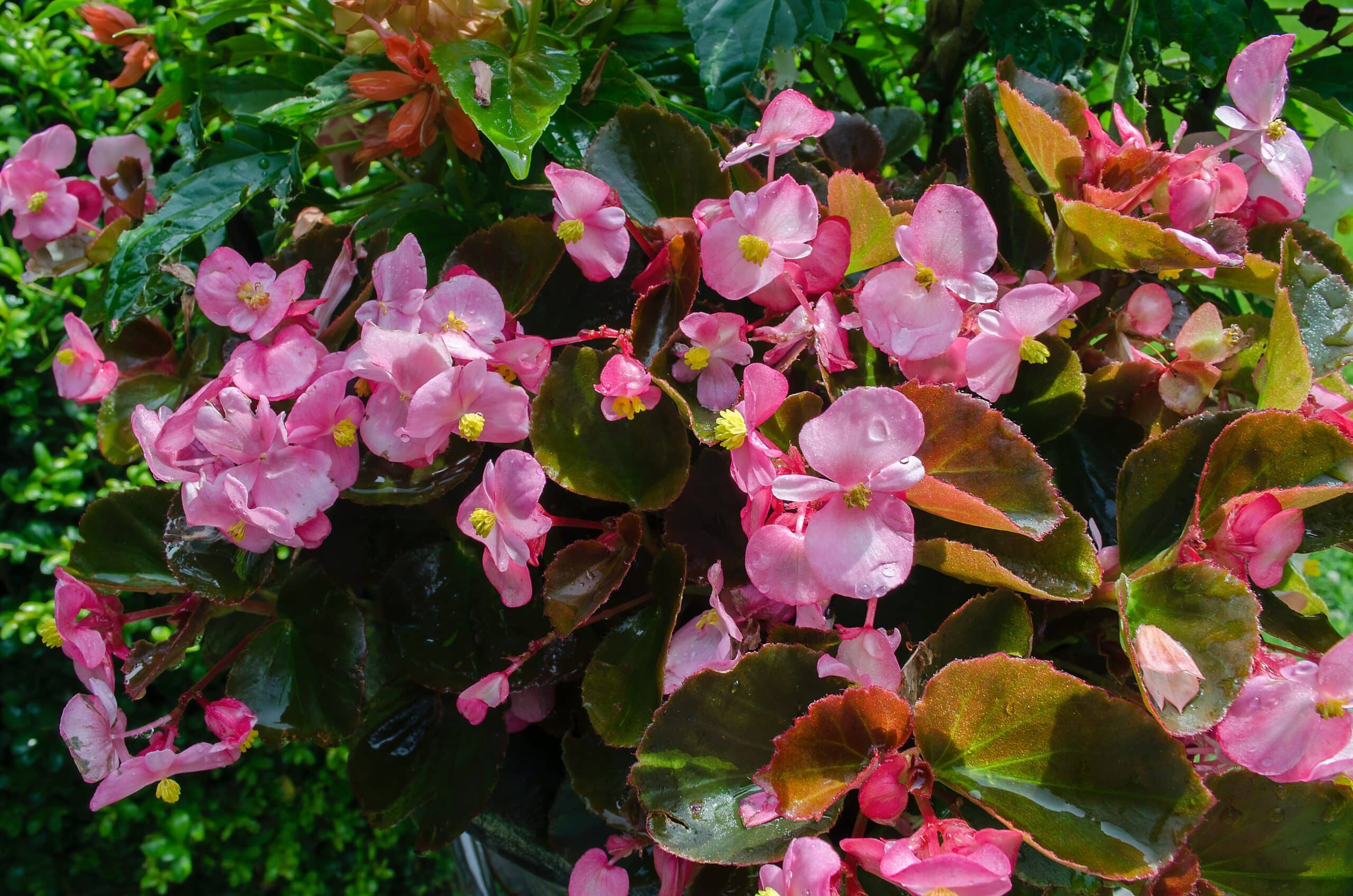Growing a wax begonia is like building a vibrant puzzle. With their lush foliage, delicate blooms, and eye-catching colors, the sight of a thriving wax begonia is sure to bring any garden to life. If you’re looking for an easy-to-care-for flower that’s sure to brighten up your outdoor space, wax begonias are the way to go.
As a specialist in botany and gardening, I’m here to tell you all there is to know about growing and caring for wax begonias. Although they can be tricky when it comes to finding the right balance of sunlight and water, with the right knowledge and care they can thrive in even the most challenging environment.
Whether you’re a beginner or an experienced gardener looking for something new, this guide will provide you with the tips and tricks needed to get the most out of your wax begonias. From selecting flowers at the nursery to taking preventative measures against pests, this comprehensive guide has everything you need to know about growing and caring for these beautiful flowers.
Where To Grow Wax Begonias
Wax begonias are a popular choice for gardeners, and rightly so. With their eye-catching blooms and low-maintenance nature, wax begonias are a wonderful addition to any outdoor space. This article will provide an overview of the best environment for wax begonias and the steps you can take to ensure their success.
When deciding where to grow wax begonias, it’s important to keep in mind that they prefer full shade or very light shade. A spot near a wall or fence can help give them additional protection from direct sun, as this can cause their foliage to scorch. Wax begonias also appreciate high humidity, so consider planting them near other plants or beneath trees that provide some shelter from the sun and wind.
In terms of soil type, wax begonias prefer moist but well-draining soil with a slightly acidic pH level (5.5–7.0). Amend your soil with compost or peat moss if necessary to achieve this balance, as it will help ensure your plants stay healthy and vibrant all season long. Additionally, remember that wax begonias can’t tolerate standing water—make sure your planting site has good drainage and doesn’t get soggy after rainstorms or heavy watering.
Now that you know the ideal conditions for growing wax begonias outdoors, it’s time to turn our attention to containers. The right kind of potting mix is essential if you want your plants to thrive in pots rather than in the ground—choose a lightweight blend designed specifically for container gardening that contains plenty of organic material and allows water to drain through quickly.
Choosing The Right Container For Wax Begonias
Irony can be seen in the fact that although wax begonias are usually grown in containers, choosing the right one seems to be a daunting task for many. After all, if you don’t give them the right environment, your begonias won’t thrive. As a botanist and gardening specialist, I’m here to make this task easier for you.
The container should be wide enough so that the roots can spread out and remain healthy. You also need to make sure that it has drainage holes so excess water can escape easily. Clay or plastic pots are good choices, but whatever material you choose, make sure it is lightweight and easy to move around.
When it comes to size, select a pot at least 6 inches (15 cm) in diameter and 4 inches (10 cm) deep. Remember that larger pots will require more soil and moisture than small ones, so adjust accordingly depending on where you plan to place your begonia. If growing indoors, consider getting a self-watering pot as this will help keep your plant’s soil moist for longer periods of time without over-watering.
Now that you know what kind of container is best suited for wax begonias, let’s take a look at what type of soil is needed for their growth and development.
Soil Requirements For Wax Begonias
When it comes to wax begonias, soil requirements are an essential part of growing a beautiful and healthy plant. First and foremost, it is important to make sure the soil is well-draining. This means you should choose a potting mix that contains peat moss or other organic material. Additionally, you may want to add some sand or perlite for increased drainage. The ideal pH for wax begonias is between 6.0 and 6.8; if necessary, adjust the pH with lime or sulfur prior to planting.
Fertilizer is also important for wax begonias; apply a balanced fertilizer every two weeks throughout the growing season. As the plant matures, reduce the amount of fertilizer and instead use a slow-release product to keep your begonia looking its best. Be sure not to overfertilize as this can lead to root burn or other damage. Also be aware that too much fertilizer can cause excess growth which can weaken stems and increase susceptibility to disease and pests.
Finally, while wax begonias don’t need a lot of water, they do need regular moisture in order for them to thrive; water when the top inch of soil feels dry but be careful not to overwater as this can lead to root rot and other issues. With proper soil requirements in place, you’ll be on your way towards growing healthy, vibrant wax begonias! Moving on from here we will discuss sunlight requirements for wax begonias in more detail.
Sunlight Requirements For Wax Begonias
If you want to grow wax begonias, then you’ll need to provide them with the right lighting conditions. These lovely plants are a popular addition to any garden or home and can be grown in hanging baskets, window boxes, or pots. With a bit of effort and know-how, it’s not hard to keep your wax begonias blooming all year round.
In order for wax begonias to thrive, they need plenty of bright light but preferably not direct sunlight. When growing indoors, position your plants near windows that receive four to five hours of indirect sunlight each day; in summer months when the sun is strong outside, consider choosing an east-facing window as this will provide more shade and protection from the intense afternoon sun. Outdoors, try to find a spot that receives dappled sunlight throughout the day – such as beneath a tree or next to a wall – this will give your plants the ideal amount of light without making them too hot in strong sunshine.
When trying out new positions for your begonia plants, begin by introducing them gradually to their new environment; start with two hours of direct light and increase the time each day until they are receiving their desired amount of illumination. This technique is known as ‘hardening off’ and helps prevent shock or stress when moving your flower from one location to another.
The next step in caring for wax begonias is understanding how much water they need…
Water Requirements For Wax Begonias
Wax begonias are beloved by gardeners for their beauty and ease of care. Consequently, adhering to the proper water requirements is essential for optimal blooming and growth. Metaphorically speaking, this is akin to providing the necessary sustenance for these flowers to thrive. To ensure that your wax begonias remain healthy and vibrant, here’s what you need to know about water requirements:
First and foremost, wax begonias prefer moist soil. The frequency with which you should water depends on several factors, such as the size of your container, how much light it receives, and the climate in which you live. Generally speaking, a good rule of thumb is to check your soil regularly rather than relying on a rigid schedule. Here’s what you should look for:
• If the top inch or two of soil feels dry, it’s time to water. • Avoid overwatering; soggy soil can cause root rot. • If you’re unsure about whether or not your plants need watering, use a moisture meter or stick your finger into the soil – if it feels damp below the surface level then there’s no need to water yet!
Given that proper watering ensures optimal growth and blooming of wax begonias, take into account each of these points when caring for them in order to maximize their potential. By understanding these needs and taking appropriate steps accordingly, your wax begonias will be sure to thrive!
Fertilizing Wax Begonias
Ah, yes. Fertilizing wax begonias: the bane of any gardener’s existence! It’s like a never-ending battle with the forces of nature, and you always seem to be on the losing side. Not to fear: I’m here to give you the lowdown on how to get your wax begonias looking their best. Here are six simple steps that’ll have you fertilizing like a pro in no time:
First up, you’ll want to make sure you’re using the right fertilizer for your plants. Look for something specifically formulated for use with wax begonias, as this will ensure the best results.
Next, decide when and how often you should fertilize. That depends on your environment and individual plants – some may need more frequent applications than others. Generally speaking, though, it’s best to apply fertilizer every couple of weeks during the growing season.
Lastly, figure out how much fertilizer is appropriate for your plants. Again, this will vary depending on their age, size and health – so use your best judgement when deciding how much fertilizer to use each time you apply it.
That wasn’t so hard now was it? I know what you’re thinking: ‘There has got to be an easier way!’ While there is no one-size-fits-all solution when it comes to fertilizing wax begonias (or any other type of plant), following these steps can help get you off on the right foot and keep your plants looking their best!
How To Propagate Wax Begonias
Propagating wax begonias is a rewarding way to increase your collection of these beautiful plants. In fact, it’s almost like creating a clone of your favorite plant! Propagation involves taking cutting from an existing plant and replanting them in soil so they can grow into new plants. It’s a relatively simple process that allows you to enjoy the beauty of wax begonias for years to come.
The most common method for propagating wax begonias is stem cuttings. You’ll need to take cuttings from healthy, mature stems, which should be about four inches long and have several leaves on them. Then, trim off the lower leaves and dip the cutting into a rooting hormone before placing it in moistened potting soil. Keep the soil damp but not wet, and place the cutting in an area with indirect sunlight until new growth appears—usually within 6-8 weeks.
Once roots have developed and new growth has emerged, you can transplant your newly propagated wax begonia into its own pot or container with fresh potting soil. Make sure you water regularly when needed—the best way to tell if your plant needs watering is by feeling the top inch of soil; if it’s dry, give it some water! With proper care, your newly propagated wax begonia will thrive and bloom for years to come.
Regular pruning and repotting are important for promoting optimal health in wax begonias as well. Pruning away dead or diseased foliage encourages air circulation through the plant’s canopy while also allowing more light to reach the lower parts of the plant; this promotes even growth throughout all parts of the plant’s structure. Additionally, repotting every 2-3 years helps keep your wax begonia growing strong by giving it access to fresh nutrients in new soil.
Common Problems With Wax Begonias
Wax begonias are a symbol of beauty and resilience, much like the people who cultivate them. Their waxy blooms brighten up any garden and add life wherever they’re planted. However, wax begonias can sometimes face problems that can cause setbacks to their growth or even death. But with the right knowledge, these problems can be avoided or managed so your begonias remain healthy and vibrant.
Common issues with wax begonias include fungal diseases such as powdery mildew or root rot caused by overwatering or poor drainage. Aphids and leaf miners can also be a problem, leading to distorted leaves and flowers that look unsightly. To prevent these issues from occurring, it’s important to ensure that your wax begonias have adequate water and light exposure while keeping an eye out for pests. In addition, regular pruning of dead foliage helps maintain a neat appearance and prevent disease from spreading.
By understanding how to identify common problems with wax begonias, you can take measures to ensure that your plants remain healthy and beautiful for years to come. With proper care and maintenance, you’ll be able to enjoy the beauty of your wax begonia blooms for many seasons! Moving forward, controlling pests on wax begonias is another important step in ensuring their health and longevity.
Controlling Pests On Wax Begonias
Caring for wax begonias is like caring for a beloved pet. It requires dedication and patience, not to mention the right amount of daily care. But when done well, these plants will reward you with their beautiful blooms and lush green foliage. To make sure your wax begonias stay healthy, there are a few things to keep in mind:
Controlling Pests: The best way to protect your begonias from pests is prevention. Inspect new plants before adding them to the garden and regularly inspect existing plants for signs of infestation. To eliminate existing infestations, remove affected leaves or stems and treat the plant with an appropriate pesticide. Monitor your plants closely to ensure any pests don’t return.
Watering: Wax begonias need a consistent amount of moisture in order to stay healthy. Avoid overwatering as this can cause root rot and other problems. Make sure the soil is evenly moist but not soggy, and water deeply once or twice per week during active growth periods (spring and summer). During winter dormancy, reduce watering significantly until new growth resumes in spring.
Fertilizing: These plants appreciate regular fertilization throughout the growing season (spring through fall). Use a balanced fertilizer every two weeks during active growth periods, then switch to a low-nitrogen fertilizer (such as fish emulsion) once flowering begins in late summer or early fall. Never fertilize during winter dormancy when the plant is not actively growing.
With proper care and attention, your wax begonia can thrive for years to come! Just remember that prevention is key when it comes to controlling pests and providing adequate moisture and nutrition for optimal health. Now that you know how to grow and care for your wax begonia, it’s time to learn how to prune them properly so they stay looking their best!
How To Prune Wax Begonias
Pruning wax begonias can be like a sculptor chipping away at a block of marble, creating beauty and balance. The process of pruning helps the plants produce fuller and more vibrant blooms. As specialist in botany and gardening, I recommend taking special care when pruning wax begonias to ensure that you don’t cut away too much or damage the plant.
To begin, you must make sure that your plant has enough foliage to support its growth. When it’s time to prune, start by removing any dead or diseased stems first. Then, identify any overly long or spindly stems and trim them back to encourage bushiness in the plant. You can also remove any faded flowers to help promote new ones. Be sure not to take off too much of the stem as this could weaken the root system that supports your wax begonia.
Once you’ve finished pruning your wax begonia, add a layer of mulch around the base of the plant to help keep weeds out and retain moisture in the soil. Watering your newly trimmed plant deeply is also important for encouraging healthy growth over time. Additionally, fertilizing with a balanced liquid fertilizer every few weeks will help keep your plant looking full and vibrant as it grows.
By following these steps for proper pruning and care for wax begonias, you can create beautiful blooms that are sure to brighten up any garden space. With just a little bit of effort and attention, your wax begonia will be healthy and flourishing all season long!
How To Winterize Wax Begonias
Winterizing wax begonias is an important step in their care and maintenance. It ensures that your plants will survive the cold winter months and come back even healthier in the spring. As a specialist in botany and gardening, I’m here to guide you through this essential process.
The first step to preparing wax begonias for winter is to trim them back in late fall. This will help protect them from frost damage by reducing their size and exposing less of the foliage to the cold air. To do this, simply cut off the top of each stem with sharp shears or pruning scissors. Be sure to leave about three inches of stem on each plant so new growth can form during the next growing season.
Next, it’s important to mulch your wax begonias with a layer of organic material such as straw, pine needles, or shredded leaves. This will provide insulation around the roots and keep them from freezing during colder temperatures. Additionally, mulching will help retain moisture in the soil so your plants don’t dry out during dry winter days.
Now that you’ve completed these two steps, your wax begonias should be prepared for winter weather! With proper protection and care, they’ll come back stronger than ever when spring arrives again – ready to bloom with beauty once more!
Tips For Keeping Wax Begonias Blooming
To ensure wax begonias remain vibrant and colorful, it’s important to keep them blooming. Thankfully, there are a few tips that can help you keep your wax begonias looking their best.
Firstly, an ideal location for wax begonias is a spot that receives plenty of bright light. This could be a south or west-facing window with curtains or blinds to filter out the intense afternoon sun during the summer months. Additionally, try to keep the temperature consistent; wax begonias prefer temperatures between 65-70 degrees Fahrenheit (18-21 degrees Celsius).
Secondly, water your wax begonias frequently. Keep the soil consistently moist but not soggy and make sure to reduce watering in winter when plants are dormant. It may also help to mist the foliage once a week during dry spells. Furthermore, fertilize your plants every two weeks with a balanced fertilizer like 10-10-10 diluted by half so as not to burn the roots of your plants.
Finally, deadhead regularly by pinching off spent flowers at their base as soon as they start wilting and fading. This encourages new growth and keeps your plant looking neat and tidy. TIP: If you find that your wax begonia isn’t blooming much, move it into brighter light or increase fertilizer applications slightly until you reach optimal results!
How To Divide Wax Begonias
Division is like a breath of fresh air for wax begonias. It can help them to bloom and thrive in their new environment. Like a gardener snipping away at an unruly bush, division gives you the chance to shape the growth of your wax begonias, making them healthier and more vibrant than ever before. Here are three key points to help guide you through this process:
When to Divide Wax Begonia: The best time to divide wax begonias is usually during early summer or late spring when they are actively growing and in peak health. Taking into account the climate in which they’re growing, it’s wise to give them some extra time to harden off before dividing them.
Preparing for Division: Before beginning the division, it’s essential that you prepare the area in which you plan on planting your new wax begonias. Make sure that there’s ample space for each new plant and that the soil is rich with nutrients. Additionally, water your wax begonias thoroughly before beginning so that they don’t dry out during the process.
Dividing Wax Begonia: Once everything is prepared, it’s time start dividing! Start by carefully removing each clump from its original pot or bed and gently pulling apart the root ball with your fingers or a small fork until it breaks apart into individual plants. Each division should have healthy roots attached for successful transplantation into its new home. Be sure not to damage any of the delicate roots as you go!
Taking these steps will help ensure success as you divide your wax begonias and provide them with a new life filled with potential growth and beauty. Now that we know how and when to divide our beloved plants, let’s move on to where we should transplant our newly divided sections!
When To Divide Wax Begonias
Dividing wax begonias is a great way to ensure healthy growth for these popular plants. Proper timing is key when it comes to dividing wax begonias, as you don’t want to divide them at the wrong time of year. When is the ideal time? Let’s take a look.
The most suitable time for dividing wax begonias is in late spring before their active growing season begins. This allows for plenty of time for new roots to form and become established prior to summer heat. It’s best to wait until after the last frost, when soil temperatures are above 60 degrees Fahrenheit (15 degrees Celsius). During this time, you should see vigorous new growth on your wax begonia plants.
Before dividing your wax begonias, make sure they have adequate moisture so that they won’t dry out during the process. You can also add some compost or other organic matter into the soil around each divided plant group; this will provide nutrients and help with water retention and drainage. Take care when dividing by gently pulling apart the clumps into smaller sections; be sure to keep as much of the root system intact as possible. Once divided, replant each section immediately in full sun or partial shade with well-draining soil, and then water thoroughly.
Now you know when it’s best to divide wax begonias – let’s move on now to how we can safely dispose of them if necessary…
How To Dispose Of Wax Begonias
Dividing wax begonias is like a relay race, where one plant passes on the baton of life to the next. It’s an important part of garden maintenance and care for these beautiful flowers. As with any living thing, however, there will come a time when we must say goodbye. Knowing when and how to dispose of wax begonias is an essential element in their cultivation.
When wax begonias start to look old or have outlived their usefulness in a garden bed, it’s time to remove them. Unfortunately, they can’t be simply thrown away; instead, they should be composted. The most effective way to do this is by cutting off all above-ground foliage and stems at the soil line before placing them in an established compost bin or pile. This helps prevent any possible disease from spreading to other plants as well as reducing waste material that might negatively impact the environment.
The composted material can then be used as a nutrient-rich fertilizer for other plants in your garden. In this way, wax begonias may continue serving you even after their passing – providing the soil with beneficial nutrients so that new plants may grow strong and healthy!
Frequently Asked Questions
Can Wax Begonias Be Grown Indoors?
Are you looking for a beautiful houseplant that is incredibly easy to care for? Well, look no further than wax begonias! These gorgeous, vibrant flowers are sure to brighten up any home, and they require practically zero effort on your part. In fact, wax begonias are so easy to care for that even the most inexperienced gardener can have success with them.
Wax begonias can be grown indoors or outdoors, depending on the climate in which you live. When grown indoors, these plants thrive in a warm spot with lots of natural light. You’ll want to water them regularly and make sure they’re not getting too much direct sun—otherwise the leaves may burn and turn brown. Additionally, you should fertilize them every couple of weeks during the growing season (spring and summer).
These remarkable plants can handle just about anything you throw at them and will reward you with an abundance of flowers all year round! With minimal effort on your part—a spot near a window and some occasional watering—you’ll have a stunning display of foliage and blooms that will bring joy to your home or garden for many years to come.
How Often Should I Water Wax Begonias?
Watering is an essential factor in the successful cultivation of wax begonias. The frequency of watering should be determined by a combination of factors, such as the size and type of plant, light intensity, temperature, and potting mix composition. Wax begonias should be watered when the top inch or two of soil is dry. It’s important to avoid both underwatering and overwatering; too much or too little water can cause problems with growth, leaf production and bloom.
When you water your wax begonias, water thoroughly so that moisture penetrates down to the roots. If you’re using a container without drainage holes (not recommended), it’s important to pour off any excess water after watering so that the soil doesn’t become soggy. Once established, wax begonias will usually need to be watered every 5-7 days during the growing season. However, if temperatures are very high or humidity is low, they may need more frequent watering.
It’s also important not to let your wax begonias dry out completely before rewatering them; this will damage their roots and stems. For best results in caring for your plants, check the soil regularly by poking your finger into it up to about an inch deep and feel if it’s moist or dry. When in doubt, err on the side of caution and give them a bit of extra water – it’s better than letting them dry out too much!
Is There A Particular Fertilizer That Works Best For Wax Begonias?
When it comes to ensuring a healthy, vibrant wax begonia plant, understanding the right fertilizer is key. Every gardener knows that appropriate fertilization can make or break your results. But what is the best fertilizer for wax begonias?
Fortunately, there are many options available that will provide your wax begonia with the nutrients it needs. A general-purpose fertilizer with an N-P-K ratio of 10-10-10 will work well, but you may need to adjust the ratio depending on the age and size of the plant. For example, a young wax begonia requires more nitrogen than phosphorus and potassium, so use a fertilizer with a higher nitrogen content such as 20-5-10 or 15-7-8. Older plants require more potassium and phosphorus than nitrogen, so use a blend like 8-12-12 or 10-20-20.
Organic fertilizers are also an excellent choice for wax begonias. Look for natural sources of nitrogen such as fish emulsion or composted manures, plus other organic additives like kelp meal or rock phosphate to ensure your Begonia plants get all their important nutrients in one application. Whatever type of fertilizer you choose, remember that too much can be just as damaging as too little – so always follow package directions carefully!
How Much Sun Do Wax Begonias Need?
Do wax begonias make good houseplants? Yes, they do! Wax begonias are known for their hardiness and colorful foliage, making them the perfect choice for an indoor plant. But how much sun do wax begonias need to thrive?
When it comes to providing light for your wax begonia, there are a few things to keep in mind. Wax begonias require bright but indirect sunlight. They can tolerate partial shade and direct morning sun, but too much intense sunlight can cause the leaves to burn. The optimal amount of sunlight for a wax begonia is about four hours each day.
It’s important to provide your wax begonia with the right amount of light if you want it to flourish indoors. Place them near a window that gets filtered sunshine or use a sheer curtain or blinds to reduce the intensity of the sunlight entering your home. This will ensure that your wax begonia gets enough light without being exposed to too much direct sun. Additionally, rotate your plant periodically so that all sides get equal exposure to light.
With proper care and attention, you can keep your wax begonia looking beautiful year-round! Make sure you provide enough sun and water, as well as fertilize regularly for best results. With these simple steps, you’ll be able to enjoy your lovely indoor plant for many years to come.
How Do I Know When Wax Begonias Need To Be Divided?
When it comes to wax begonias, knowing when to divide them is key for a healthy and long-lasting plant. In the same way that an experienced gardener can tell when a flower needs watering or fertilizer, they can also recognize when it’s time to divide a wax begonia. This is an important skill that will help ensure your plant lives for many years to come.
For novice gardeners, it may not be immediately obvious when division is needed. An easy way to tell is by looking at the center of the cluster of flowers: if you see any dead or yellowing blooms, this indicates that division may be necessary. Additionally, if the stems are becoming woody and no longer producing flowers, this could also mean that division is needed.
To properly execute division of a wax begonia, start by gently digging up the entire clump with a shovel and then separate out individual plants with your hands or garden shears. It’s essential to have good soil drainage when replanting your divisions so make sure you add plenty of compost before planting in a sunny spot in order to give them the best chance at success. With proper care and attention, these divisions will flourish in their new homes and you’ll enjoy beautiful blooms for years to come!
Conclusion
Wax begonias are a great addition to any garden. Not only do they add color and vibrancy to the area, but they also require very little maintenance. When properly cared for, wax begonias can live up to 10 years or more.
With the right amount of sunlight, water, and fertilizer, wax begonias can thrive in almost any space. The key is understanding how much sun and water your plants need and when to fertilize them. Additionally, knowing when to divide your wax begonias will help keep them healthy and happy.
The beauty of wax begonias is that they can be grown both indoors and outdoors with minimal effort. With the right care, these plants will add beautiful texture and color to your garden year-round. So if you’re looking for a low-maintenance flower that provides plenty of visual interest all season long, consider adding some wax begonias to your landscape!

























![How To Clean A Wax Warmer 38 [1425] Wax Moth (Galleria mellonella)](https://green-life.blog/wp-content/uploads/2023/05/TlTgCqusrajq-150x150.jpg.webp)



